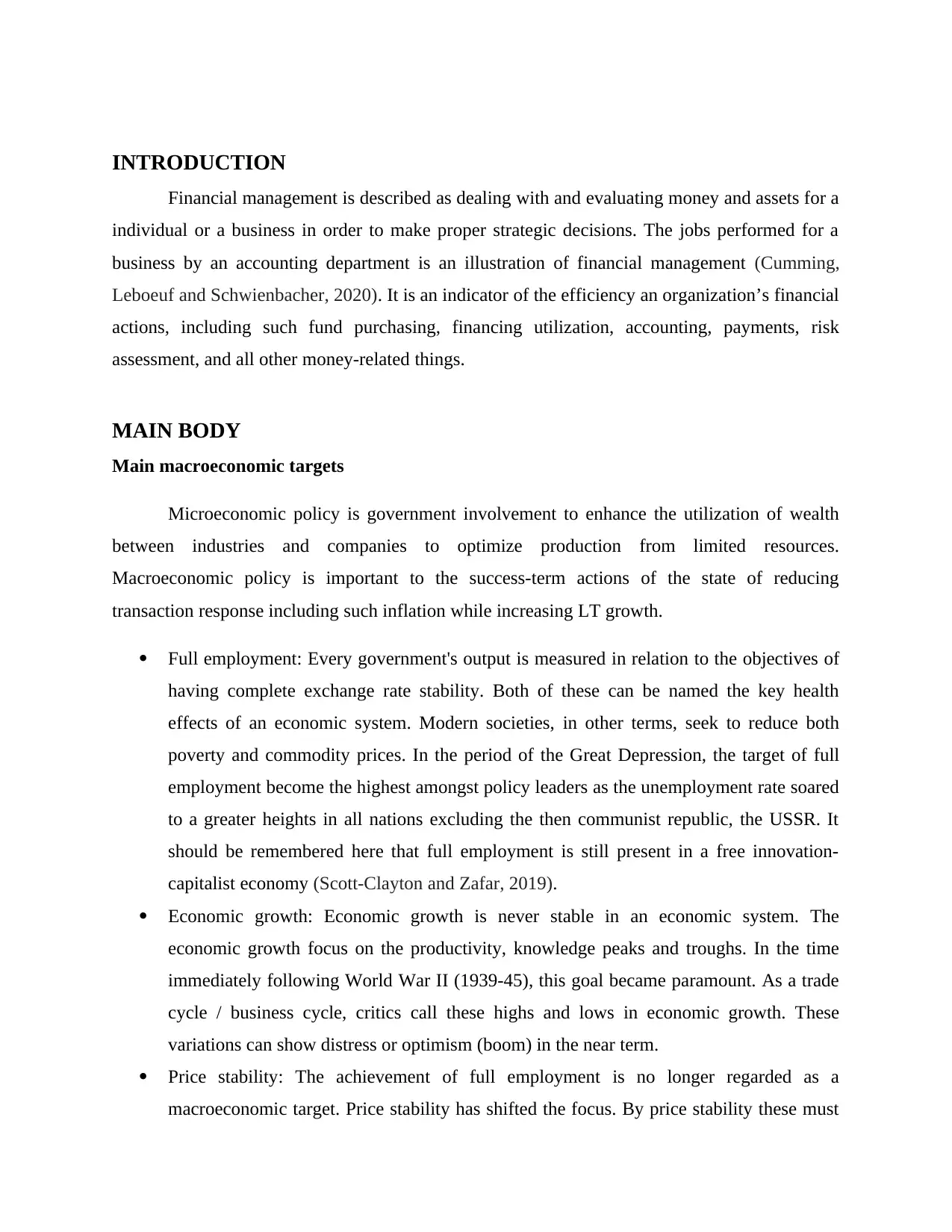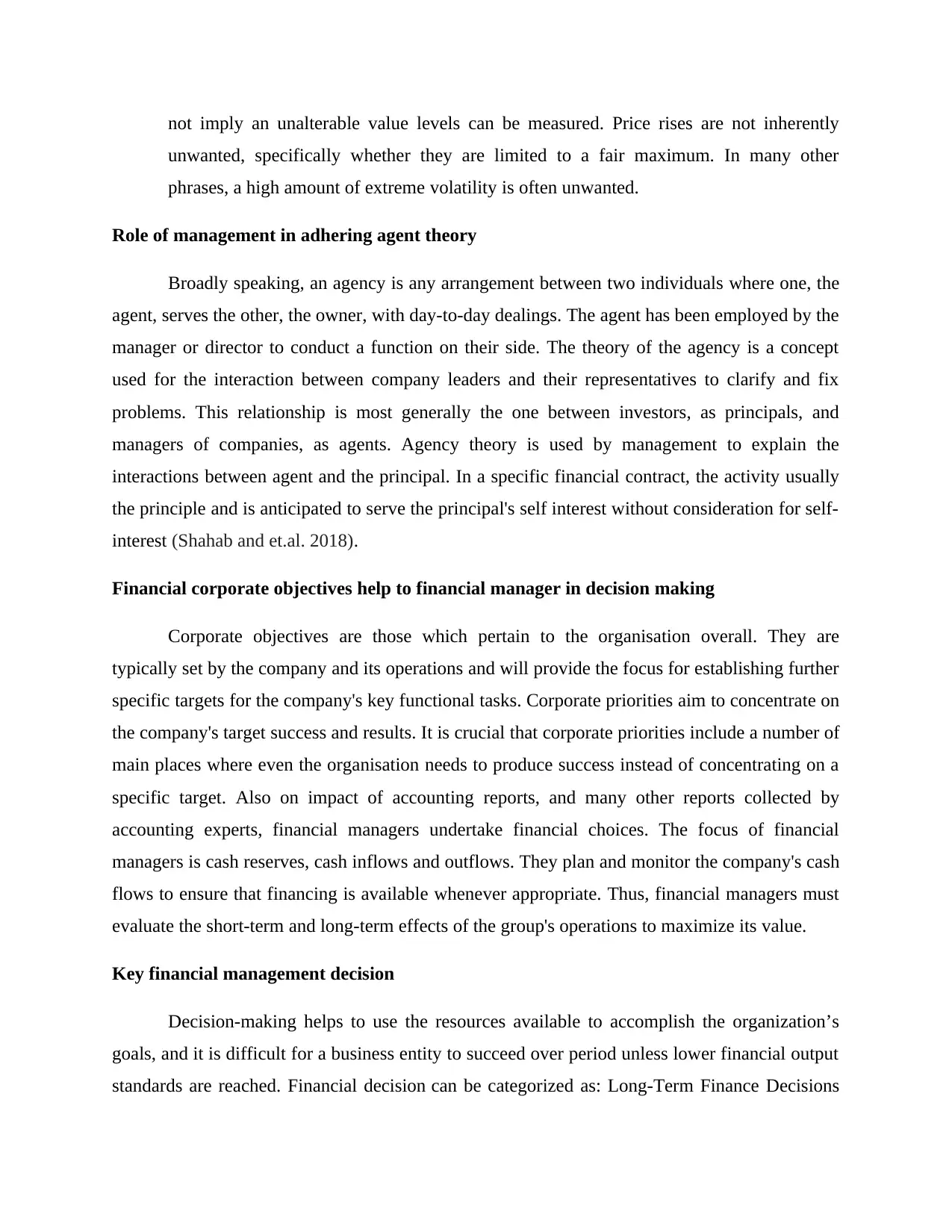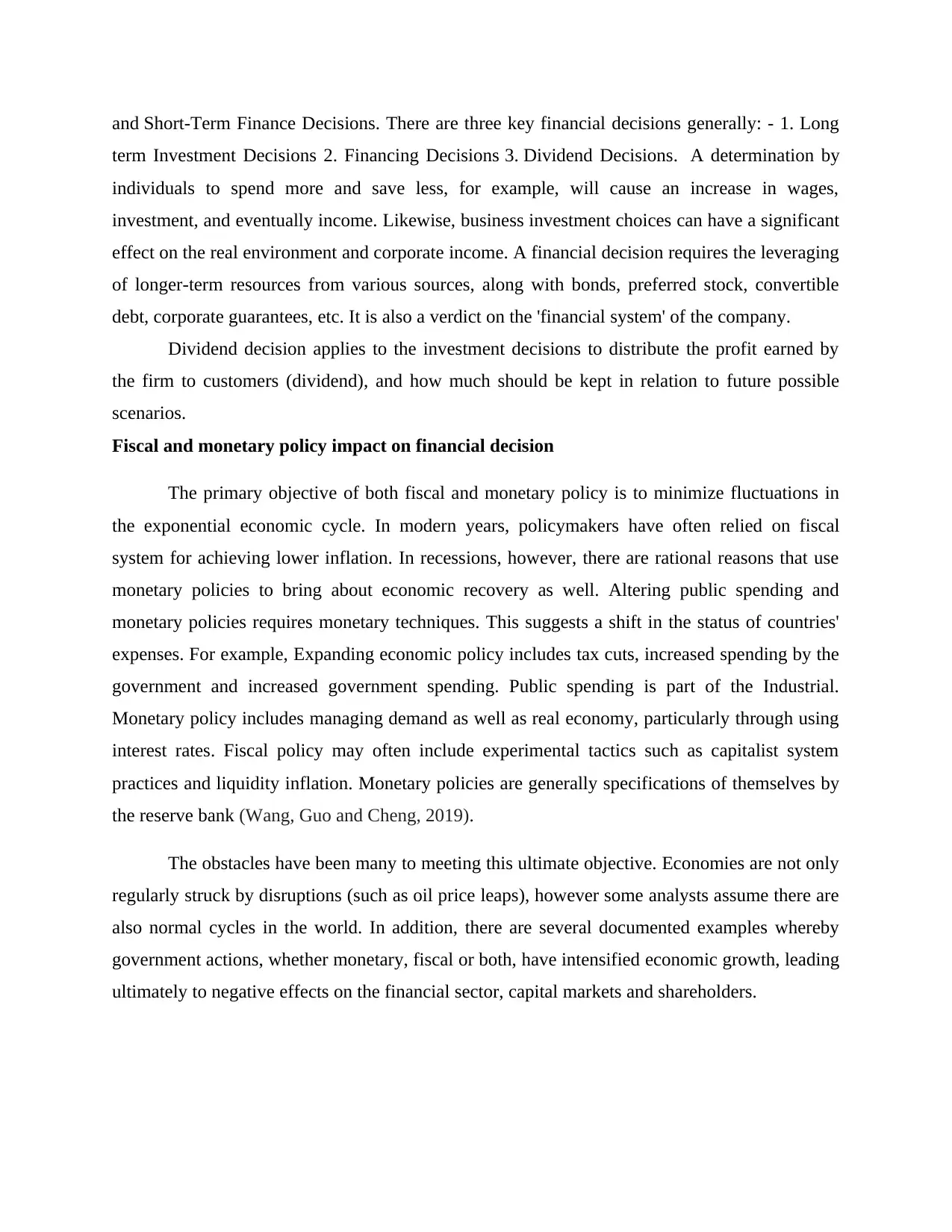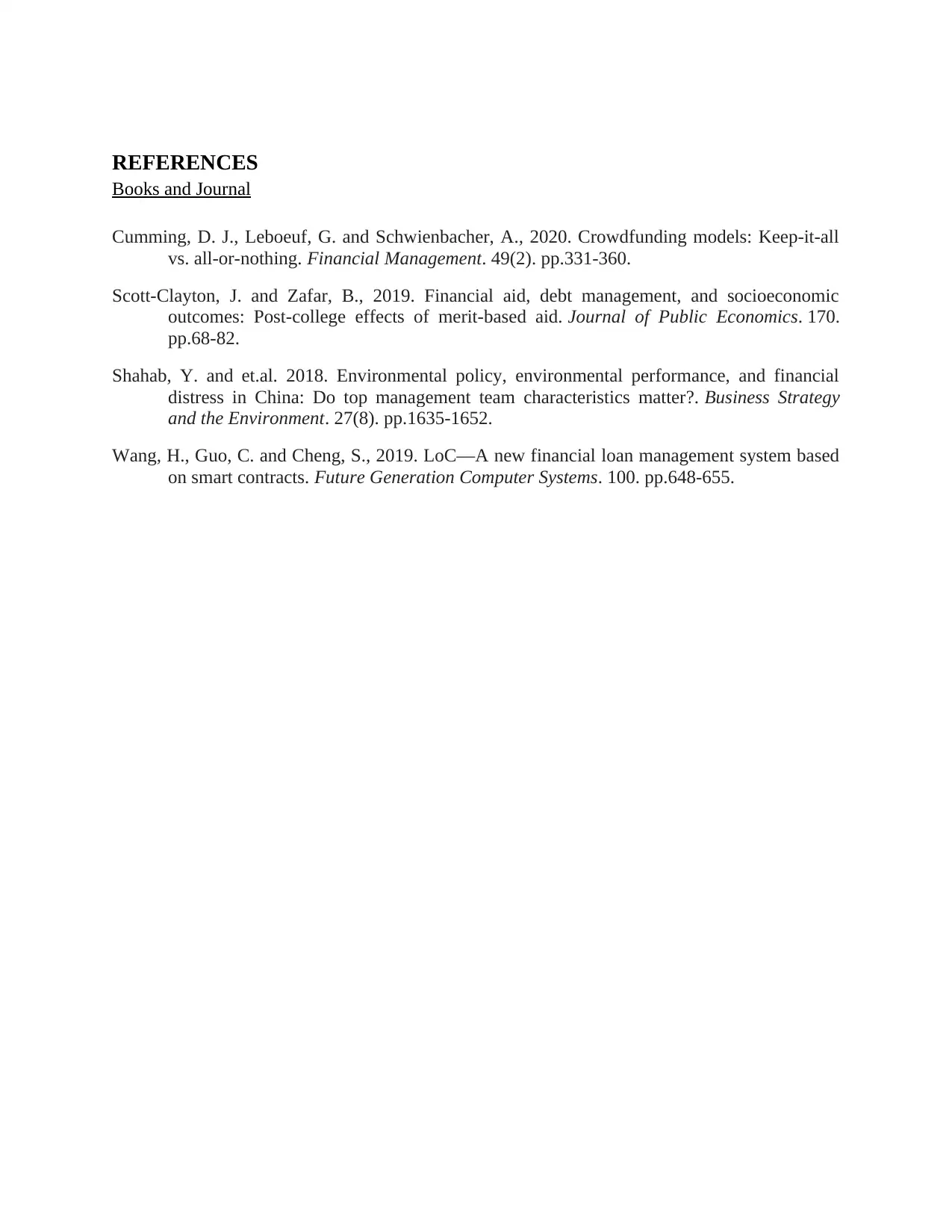Financial Management: Decisions, Policies, and Impact Analysis
VerifiedAdded on 2023/01/06
|10
|1371
|51
Report
AI Summary
This report provides a comprehensive overview of financial management, delving into its core principles and applications. It begins by defining financial management and its role in strategic decision-making within businesses, emphasizing the functions of accounting departments. The report then ...

Financial Management
Paraphrase This Document
Need a fresh take? Get an instant paraphrase of this document with our AI Paraphraser


You're viewing a preview
Unlock full access by subscribing today!

Paraphrase This Document
Need a fresh take? Get an instant paraphrase of this document with our AI Paraphraser

Contents
INTRODUCTION...........................................................................................................................................5
MAIN BODY.................................................................................................................................................5
CONCLUSION...............................................................................................................................................7
REFERENCES................................................................................................................................................9
INTRODUCTION...........................................................................................................................................5
MAIN BODY.................................................................................................................................................5
CONCLUSION...............................................................................................................................................7
REFERENCES................................................................................................................................................9

INTRODUCTION
Financial management is described as dealing with and evaluating money and assets for a
individual or a business in order to make proper strategic decisions. The jobs performed for a
business by an accounting department is an illustration of financial management (Cumming,
Leboeuf and Schwienbacher, 2020). It is an indicator of the efficiency an organization’s financial
actions, including such fund purchasing, financing utilization, accounting, payments, risk
assessment, and all other money-related things.
MAIN BODY
Main macroeconomic targets
Microeconomic policy is government involvement to enhance the utilization of wealth
between industries and companies to optimize production from limited resources.
Macroeconomic policy is important to the success-term actions of the state of reducing
transaction response including such inflation while increasing LT growth.
Full employment: Every government's output is measured in relation to the objectives of
having complete exchange rate stability. Both of these can be named the key health
effects of an economic system. Modern societies, in other terms, seek to reduce both
poverty and commodity prices. In the period of the Great Depression, the target of full
employment become the highest amongst policy leaders as the unemployment rate soared
to a greater heights in all nations excluding the then communist republic, the USSR. It
should be remembered here that full employment is still present in a free innovation-
capitalist economy (Scott-Clayton and Zafar, 2019).
Economic growth: Economic growth is never stable in an economic system. The
economic growth focus on the productivity, knowledge peaks and troughs. In the time
immediately following World War II (1939-45), this goal became paramount. As a trade
cycle / business cycle, critics call these highs and lows in economic growth. These
variations can show distress or optimism (boom) in the near term.
Price stability: The achievement of full employment is no longer regarded as a
macroeconomic target. Price stability has shifted the focus. By price stability these must
Financial management is described as dealing with and evaluating money and assets for a
individual or a business in order to make proper strategic decisions. The jobs performed for a
business by an accounting department is an illustration of financial management (Cumming,
Leboeuf and Schwienbacher, 2020). It is an indicator of the efficiency an organization’s financial
actions, including such fund purchasing, financing utilization, accounting, payments, risk
assessment, and all other money-related things.
MAIN BODY
Main macroeconomic targets
Microeconomic policy is government involvement to enhance the utilization of wealth
between industries and companies to optimize production from limited resources.
Macroeconomic policy is important to the success-term actions of the state of reducing
transaction response including such inflation while increasing LT growth.
Full employment: Every government's output is measured in relation to the objectives of
having complete exchange rate stability. Both of these can be named the key health
effects of an economic system. Modern societies, in other terms, seek to reduce both
poverty and commodity prices. In the period of the Great Depression, the target of full
employment become the highest amongst policy leaders as the unemployment rate soared
to a greater heights in all nations excluding the then communist republic, the USSR. It
should be remembered here that full employment is still present in a free innovation-
capitalist economy (Scott-Clayton and Zafar, 2019).
Economic growth: Economic growth is never stable in an economic system. The
economic growth focus on the productivity, knowledge peaks and troughs. In the time
immediately following World War II (1939-45), this goal became paramount. As a trade
cycle / business cycle, critics call these highs and lows in economic growth. These
variations can show distress or optimism (boom) in the near term.
Price stability: The achievement of full employment is no longer regarded as a
macroeconomic target. Price stability has shifted the focus. By price stability these must
You're viewing a preview
Unlock full access by subscribing today!

not imply an unalterable value levels can be measured. Price rises are not inherently
unwanted, specifically whether they are limited to a fair maximum. In many other
phrases, a high amount of extreme volatility is often unwanted.
Role of management in adhering agent theory
Broadly speaking, an agency is any arrangement between two individuals where one, the
agent, serves the other, the owner, with day-to-day dealings. The agent has been employed by the
manager or director to conduct a function on their side. The theory of the agency is a concept
used for the interaction between company leaders and their representatives to clarify and fix
problems. This relationship is most generally the one between investors, as principals, and
managers of companies, as agents. Agency theory is used by management to explain the
interactions between agent and the principal. In a specific financial contract, the activity usually
the principle and is anticipated to serve the principal's self interest without consideration for self-
interest (Shahab and et.al. 2018).
Financial corporate objectives help to financial manager in decision making
Corporate objectives are those which pertain to the organisation overall. They are
typically set by the company and its operations and will provide the focus for establishing further
specific targets for the company's key functional tasks. Corporate priorities aim to concentrate on
the company's target success and results. It is crucial that corporate priorities include a number of
main places where even the organisation needs to produce success instead of concentrating on a
specific target. Also on impact of accounting reports, and many other reports collected by
accounting experts, financial managers undertake financial choices. The focus of financial
managers is cash reserves, cash inflows and outflows. They plan and monitor the company's cash
flows to ensure that financing is available whenever appropriate. Thus, financial managers must
evaluate the short-term and long-term effects of the group's operations to maximize its value.
Key financial management decision
Decision-making helps to use the resources available to accomplish the organization’s
goals, and it is difficult for a business entity to succeed over period unless lower financial output
standards are reached. Financial decision can be categorized as: Long-Term Finance Decisions
unwanted, specifically whether they are limited to a fair maximum. In many other
phrases, a high amount of extreme volatility is often unwanted.
Role of management in adhering agent theory
Broadly speaking, an agency is any arrangement between two individuals where one, the
agent, serves the other, the owner, with day-to-day dealings. The agent has been employed by the
manager or director to conduct a function on their side. The theory of the agency is a concept
used for the interaction between company leaders and their representatives to clarify and fix
problems. This relationship is most generally the one between investors, as principals, and
managers of companies, as agents. Agency theory is used by management to explain the
interactions between agent and the principal. In a specific financial contract, the activity usually
the principle and is anticipated to serve the principal's self interest without consideration for self-
interest (Shahab and et.al. 2018).
Financial corporate objectives help to financial manager in decision making
Corporate objectives are those which pertain to the organisation overall. They are
typically set by the company and its operations and will provide the focus for establishing further
specific targets for the company's key functional tasks. Corporate priorities aim to concentrate on
the company's target success and results. It is crucial that corporate priorities include a number of
main places where even the organisation needs to produce success instead of concentrating on a
specific target. Also on impact of accounting reports, and many other reports collected by
accounting experts, financial managers undertake financial choices. The focus of financial
managers is cash reserves, cash inflows and outflows. They plan and monitor the company's cash
flows to ensure that financing is available whenever appropriate. Thus, financial managers must
evaluate the short-term and long-term effects of the group's operations to maximize its value.
Key financial management decision
Decision-making helps to use the resources available to accomplish the organization’s
goals, and it is difficult for a business entity to succeed over period unless lower financial output
standards are reached. Financial decision can be categorized as: Long-Term Finance Decisions
Paraphrase This Document
Need a fresh take? Get an instant paraphrase of this document with our AI Paraphraser

and Short-Term Finance Decisions. There are three key financial decisions generally: - 1. Long
term Investment Decisions 2. Financing Decisions 3. Dividend Decisions. A determination by
individuals to spend more and save less, for example, will cause an increase in wages,
investment, and eventually income. Likewise, business investment choices can have a significant
effect on the real environment and corporate income. A financial decision requires the leveraging
of longer-term resources from various sources, along with bonds, preferred stock, convertible
debt, corporate guarantees, etc. It is also a verdict on the 'financial system' of the company.
Dividend decision applies to the investment decisions to distribute the profit earned by
the firm to customers (dividend), and how much should be kept in relation to future possible
scenarios.
Fiscal and monetary policy impact on financial decision
The primary objective of both fiscal and monetary policy is to minimize fluctuations in
the exponential economic cycle. In modern years, policymakers have often relied on fiscal
system for achieving lower inflation. In recessions, however, there are rational reasons that use
monetary policies to bring about economic recovery as well. Altering public spending and
monetary policies requires monetary techniques. This suggests a shift in the status of countries'
expenses. For example, Expanding economic policy includes tax cuts, increased spending by the
government and increased government spending. Public spending is part of the Industrial.
Monetary policy includes managing demand as well as real economy, particularly through using
interest rates. Fiscal policy may often include experimental tactics such as capitalist system
practices and liquidity inflation. Monetary policies are generally specifications of themselves by
the reserve bank (Wang, Guo and Cheng, 2019).
The obstacles have been many to meeting this ultimate objective. Economies are not only
regularly struck by disruptions (such as oil price leaps), however some analysts assume there are
also normal cycles in the world. In addition, there are several documented examples whereby
government actions, whether monetary, fiscal or both, have intensified economic growth, leading
ultimately to negative effects on the financial sector, capital markets and shareholders.
term Investment Decisions 2. Financing Decisions 3. Dividend Decisions. A determination by
individuals to spend more and save less, for example, will cause an increase in wages,
investment, and eventually income. Likewise, business investment choices can have a significant
effect on the real environment and corporate income. A financial decision requires the leveraging
of longer-term resources from various sources, along with bonds, preferred stock, convertible
debt, corporate guarantees, etc. It is also a verdict on the 'financial system' of the company.
Dividend decision applies to the investment decisions to distribute the profit earned by
the firm to customers (dividend), and how much should be kept in relation to future possible
scenarios.
Fiscal and monetary policy impact on financial decision
The primary objective of both fiscal and monetary policy is to minimize fluctuations in
the exponential economic cycle. In modern years, policymakers have often relied on fiscal
system for achieving lower inflation. In recessions, however, there are rational reasons that use
monetary policies to bring about economic recovery as well. Altering public spending and
monetary policies requires monetary techniques. This suggests a shift in the status of countries'
expenses. For example, Expanding economic policy includes tax cuts, increased spending by the
government and increased government spending. Public spending is part of the Industrial.
Monetary policy includes managing demand as well as real economy, particularly through using
interest rates. Fiscal policy may often include experimental tactics such as capitalist system
practices and liquidity inflation. Monetary policies are generally specifications of themselves by
the reserve bank (Wang, Guo and Cheng, 2019).
The obstacles have been many to meeting this ultimate objective. Economies are not only
regularly struck by disruptions (such as oil price leaps), however some analysts assume there are
also normal cycles in the world. In addition, there are several documented examples whereby
government actions, whether monetary, fiscal or both, have intensified economic growth, leading
ultimately to negative effects on the financial sector, capital markets and shareholders.

CONCLUSION
As per the above report it has been concluded that financial management is broad activity
that conduct by every organization. It is a procedure of preparing, analyzing and controlling the
financial resources to accomplish all the goals and objectives of the business in particular period
of time.
As per the above report it has been concluded that financial management is broad activity
that conduct by every organization. It is a procedure of preparing, analyzing and controlling the
financial resources to accomplish all the goals and objectives of the business in particular period
of time.
You're viewing a preview
Unlock full access by subscribing today!

REFERENCES
Books and Journal
Cumming, D. J., Leboeuf, G. and Schwienbacher, A., 2020. Crowdfunding models: Keep‐it‐all
vs. all‐or‐nothing. Financial Management. 49(2). pp.331-360.
Scott-Clayton, J. and Zafar, B., 2019. Financial aid, debt management, and socioeconomic
outcomes: Post-college effects of merit-based aid. Journal of Public Economics. 170.
pp.68-82.
Shahab, Y. and et.al. 2018. Environmental policy, environmental performance, and financial
distress in China: Do top management team characteristics matter?. Business Strategy
and the Environment. 27(8). pp.1635-1652.
Wang, H., Guo, C. and Cheng, S., 2019. LoC—A new financial loan management system based
on smart contracts. Future Generation Computer Systems. 100. pp.648-655.
Books and Journal
Cumming, D. J., Leboeuf, G. and Schwienbacher, A., 2020. Crowdfunding models: Keep‐it‐all
vs. all‐or‐nothing. Financial Management. 49(2). pp.331-360.
Scott-Clayton, J. and Zafar, B., 2019. Financial aid, debt management, and socioeconomic
outcomes: Post-college effects of merit-based aid. Journal of Public Economics. 170.
pp.68-82.
Shahab, Y. and et.al. 2018. Environmental policy, environmental performance, and financial
distress in China: Do top management team characteristics matter?. Business Strategy
and the Environment. 27(8). pp.1635-1652.
Wang, H., Guo, C. and Cheng, S., 2019. LoC—A new financial loan management system based
on smart contracts. Future Generation Computer Systems. 100. pp.648-655.
1 out of 10
Related Documents
Your All-in-One AI-Powered Toolkit for Academic Success.
+13062052269
info@desklib.com
Available 24*7 on WhatsApp / Email
![[object Object]](/_next/static/media/star-bottom.7253800d.svg)
Unlock your academic potential
© 2024 | Zucol Services PVT LTD | All rights reserved.





